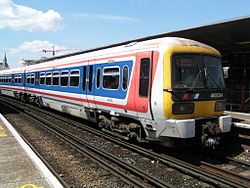Network South East
 |
|
| Overview | |
|---|---|
| Franchise(s) | Not subject to franchising |
| Main region(s) | London, South East |
| Other region(s) | East of England, South West, West Midlands, East Midlands, Thames Valley |
| Fleet size | Carriages: 6700 (1986) |
| Stations called at | 930 (1986) |
| Parent company | British Rail |
Network SouthEast (NSE) was one of the three passenger sectors of British Rail created in 1982. NSE principally operated commuter trains in the London area and inter-urban services in densely populated South East England, although the network reached as far west as Exeter. Before 1986, the sector was known as London & South Eastern.
In the privatisation of British Rail on 1 April 1994 it was gradually broken into a number of franchises.
Before the sectorisation of British Rail in 1982 the system was split into largely autonomous regional operations: those operating around London were the London Midland Region, Southern Region, Western Region and Eastern Region. Sectorisation of BR altered this setup by instead organising by the traffic type: commuter services in the south-east of England, long distance intercity services, local services in the UK regions, parcels and freight. The aim was to introduce greater budgetary efficiency and managerial accountability by building a more market-focused and responsive business, rather than privatising BR outright. It was expected that the London and South East sector would cover most of its operating costs from revenues, in contrast to heavily subsidised rural services.
Upon sectorisation, the London & South Eastern sector took over responsibility for passenger services in the south-east of England, working with the existing BR business units of Regions and Functions to deliver the overall service. Day-to-day operation, staffing and timetabling continued to be delivered by the Regions - and the sector came into existence with barely 30 staff based at Waterloo.
On 10 June 1986, L&SE was relaunched as Network SouthEast, along with a new red, white and blue livery. The relaunch was intended to be more than a superficial rebranding and was underpinned by considerable investment in the presentation of stations and trains, as well as efforts to improve service standards. This approach was largely brought about by a new director, Chris Green, who had presided over similar transformation and rebranding of ScotRail.
...
Wikipedia
